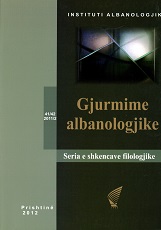KRAHASIMI I SISTEMEVE TË FORMAVE GRAMATIKORE TË KOHËS SË SHKUAR TË FOLJEVE TË MËNYRËS DËFTORE NË GJUHËN SHQIPE DHE NË GJUHËN ITALIANE
COMPARISON OF GRAMMATICAL FORMS SYSTEMS OF INDICATIVE PAST TENSE OF VERBS IN ALBANIAN AND ITALIAN LANGUAGE
Author(s): Adrian HaxhillaziSubject(s): Language and Literature Studies
Published by: Instituti Albanologjik i Prishtinës
Keywords: COMPARISON OF GRAMMATICAL FORMS ; SYSTEMS OF INDICATIVE ; PAST TENSE OF VERBS ; ALBANIAN AND ITALIAN LANGUAGE
Summary/Abstract: Grammatical forms of indicative past tense of verbs, both in Albanian and Italian language, can be seen as separate groups according to the systemic concept as a hierarchical escalated classification. In the indicative mood the Albanian past tense of verbs has a grammatical forms’ system made of seven (7) linguistic tenses (e pakryera (=imperfect), e kryera e thjeshtë (=past tense), e kryera e përbërë (=past perfect), e kryera e mbipërbërë, më se e kryera e përbërë, më se e kryera e mbipërbërë and e kryera e tejshkuar). In the indicative mood the Italian past tense of verbs has a grammatical forms’ system made of five (5) linguistic tenses (l’imperfetto (=imperfect), il passato remoto (=past tense), il passato prossimo (=past perfect), il trapassato prossimo and il trapassato remoto). Formal grammatical differences related to the verbs conjugation paradigm and tenses semantic differences regarding the verbal diathesis, the person grammatical category, number and verb mood (the modality) are the same for both the Albanian and Italian language. In the past tense system the Albanian language has two (2) over-compound grammatical forms (e kryera e mbipërbërë dhe më se e kryera e mbipërbërë), whereas the Italian language does not have these forms, because their meanings come from perfect grammatical forms (il passato prossimo) and more than perfect (il trapassato prossimo). In the past grammatical forms of the Albanian and Italian verbs, there coexist and intermingle two (2) main grammatical meanings: time meaning and aspect meaning. Other semantics-grammatical features exist and have an impact in the verbal semantics of these languages; they are related to the verb action mood (German Aksionsart), transitive and intransitive verbs, specified or unspecified action of the verb, as well as continuous or discontinuous action of the verb with the moment of speech. Albanian and Italian language have only one past tense grammatical form regarding the unfinished aspect of the verb and this is the imperfect tense (e pakryera in Albanian and l’imperfetto in Italian). All other past tense grammatical forms, for both the Albanian and Italian languages, have the grammatical meaning of a finished aspect. In the Albanian language the e pakryera (=imperfect), e kryera e thjeshtë (=past tense) and e kryera e përbërë (=past perfect), the point of reference is the present, whereas in the Italian language the verbs referring to the present are: l’imperfetto (=imperfect), il passato remoto (=past tense) and il passato prossimo (=past perfect). In case of e kryera e mbipërbërë, më se e kryera e përbërë, më se e kryera e mbipërbërë and e kryera e tejshkuar of the Albanian language, the point of reference is shifted to the past. Even the Italian language refers to the past in two (2) analytical grammatical forms: il trapassato prossimo and il trapassato remoto.
Journal: Gjurmime Albanologjike - Seria e shkencave filologjike
- Issue Year: 2011
- Issue No: 41-42
- Page Range: 171-186
- Page Count: 16
- Language: Albanian
- Content File-PDF

